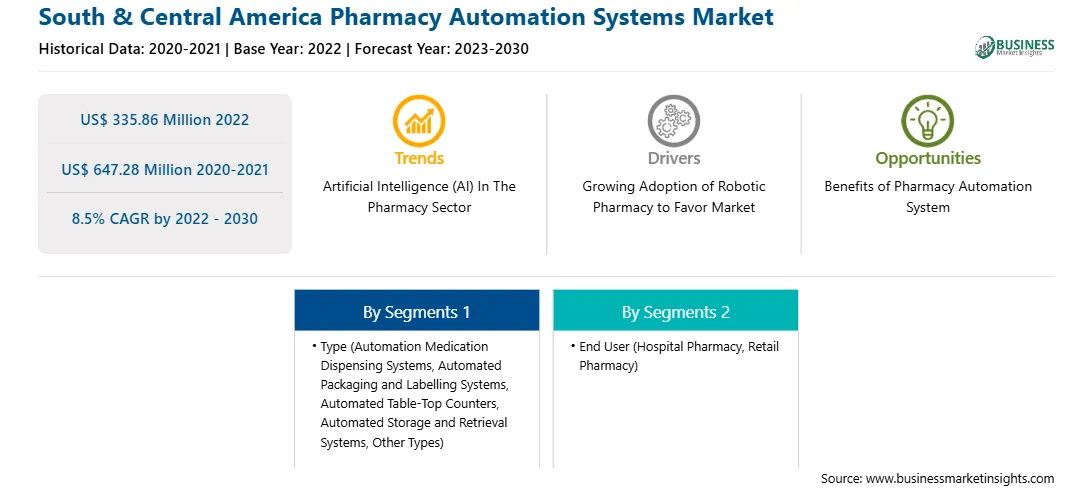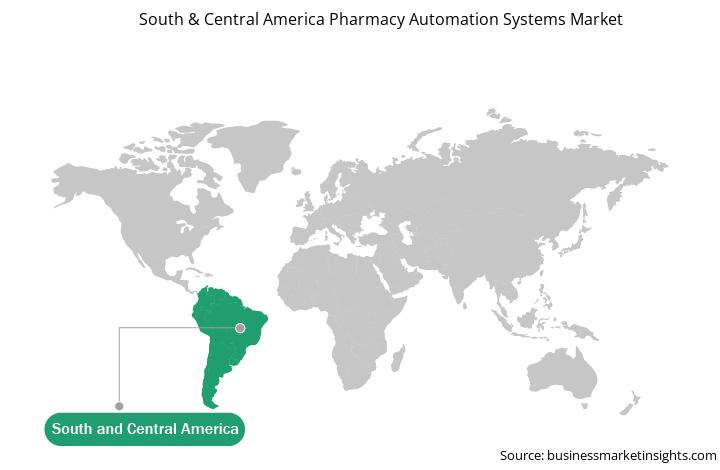The South & Central America pharmacy automation systems market was valued at US$ 335.86 million in 2022 and is expected to reach US$ 647.28 million by 2030; it is estimated to grow at a CAGR of 8.5% from 2022 to 2030.
Rising Aging Population Fuel the South & Central America Pharmacy Automation Systems Market
The aging population is a key to advancements in the healthcare sector. Thus, the growing aging population is anticipated to serve vital growth opportunities for the pharmacy. According to the United Nations' World Population Prospects 2022 report, the elderly population is projected to increase from 10% of the total population in 2022 to 16% of the total population by 2050. The rapidly growing aging population indicates that there will be exponential demand for care and medicines. Older people live with one or more chronic medical conditions, such as arthritis, diabetes, Alzheimer's, or Parkinson's; the treatments of these conditions require regular refilling of medicines. Also, there is growth in life expectancy worldwide, leading to the need for more digital and automated systems for adult care.
The development of automatic medicine dispensers has served beneficially in developed regions. Advanced features such as an LED display, a motor controller, and an alarm system help people with medication reminders. Automated pharmacy systems would enable them to keep track of their medicine and stocks better. Further, the implementation of automated pharmacy systems has been proven to trigger medication adherence in adults. With such features, the adoption of automated pharmacy systems is expected to grow in the coming years.
South & Central America Pharmacy Automation Systems Market Overview
The pharmacy automation systems market in South & Central America is segmented into Brazil, Chile, and the Rest of South & Central America. The pharmacy automation systems market has served growth opportunities in Brazil due to growing medical tourism and improving healthcare infrastructure, which is anticipated to increase the adoption of pharmacy automation systems in the region.
In Brazil, the pharmacy automation systems market is in the early stages. Nationwide, Brazilian hospitals have deployed PillPick and BoxPicker, provided by Swisslog Healthcare. Healthcare facilities in the urban areas of Brazil are well-developed and majorly operated by the private sector. Therefore, it is estimated that the private sector has adopted automated dispensing systems in their facility centers, contributing significantly to the market growth. In addition, growing spending on technological advancements and increasing government initiatives for integrating automatic dispensing machines in healthcare facilities are leading to market growth.
South & Central America Pharmacy Automation Systems Market Revenue and Forecast to 2030 (US$ Million)
Strategic insights for the South & Central America Pharmacy Automation Systems provides data-driven analysis of the industry landscape, including current trends, key players, and regional nuances. These insights offer actionable recommendations, enabling readers to differentiate themselves from competitors by identifying untapped segments or developing unique value propositions. Leveraging data analytics, these insights help industry players anticipate the market shifts, whether investors, manufacturers, or other stakeholders. A future-oriented perspective is essential, helping stakeholders anticipate market shifts and position themselves for long-term success in this dynamic region. Ultimately, effective strategic insights empower readers to make informed decisions that drive profitability and achieve their business objectives within the market.

| Report Attribute | Details |
|---|---|
| Market size in 2022 | US$ 335.86 Million |
| Market Size by 2030 | US$ 647.28 Million |
| Global CAGR (2022 - 2030) | 8.5% |
| Historical Data | 2020-2021 |
| Forecast period | 2023-2030 |
| Segments Covered |
By Type
|
| Regions and Countries Covered | South and Central America
|
| Market leaders and key company profiles |
The geographic scope of the South & Central America Pharmacy Automation Systems refers to the specific areas in which a business operates and competes. Understanding local distinctions, such as diverse consumer preferences (e.g., demand for specific plug types or battery backup durations), varying economic conditions, and regulatory environments, is crucial for tailoring strategies to specific markets. Businesses can expand their reach by identifying underserved areas or adapting their offerings to meet local demands. A clear market focus allows for more effective resource allocation, targeted marketing campaigns, and better positioning against local competitors, ultimately driving growth in those targeted areas.

1. Becton Dickinson and Co
2. Capsa Solutions LLC
3. Omnicell Inc
4. Oracle Corp
5. Swisslog Healthcare AG
The South & Central America Pharmacy Automation Systems Market is valued at US$ 335.86 Million in 2022, it is projected to reach US$ 647.28 Million by 2030.
As per our report South & Central America Pharmacy Automation Systems Market, the market size is valued at US$ 335.86 Million in 2022, projecting it to reach US$ 647.28 Million by 2030. This translates to a CAGR of approximately 8.5% during the forecast period.
The South & Central America Pharmacy Automation Systems Market report typically cover these key segments-
The historic period, base year, and forecast period can vary slightly depending on the specific market research report. However, for the South & Central America Pharmacy Automation Systems Market report:
The South & Central America Pharmacy Automation Systems Market is populated by several key players, each contributing to its growth and innovation. Some of the major players include:
The South & Central America Pharmacy Automation Systems Market report is valuable for diverse stakeholders, including:
Essentially, anyone involved in or considering involvement in the South & Central America Pharmacy Automation Systems Market value chain can benefit from the information contained in a comprehensive market report.